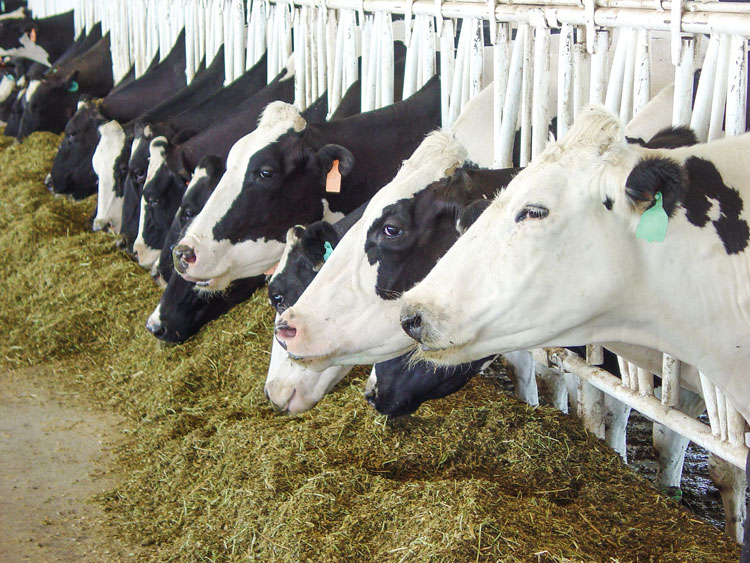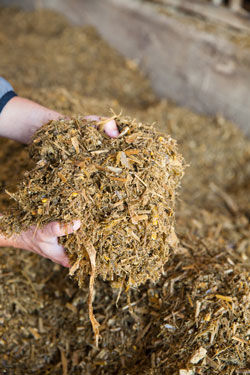
It is common for producers to experience lower butterfat tests and higher numbers of butterfat inversions this time of year. The cause is likely an abrupt change from old corn silage to recently fermented corn silage. Smoothing this transition can help maintain — or even exceed — goals for milk production and milk component yield (MCY).

Start with starch
Efficiently processing corn kernels at silage harvest helps support energy and milk production, but starch digestibility is also directly affected by the ensiling process itself.1 After six to eight months in storage, the fermentation process continues to break down starch-protein structures in the corn silage or high-moisture shell corn (HMSC). Adding a proven silage inoculant containing enzymes during harvest can help break down plant fiber and improve fiber digestibility.
The increased amounts of rumen-digestible starch and digestibility of the starch can combine to push cows into Sub Acute Ruminal Acidosis (SARA).2,3,4 Acid and microbes don’t mix A cow is defined as experiencing SARA when her rumen pH is below 5.8 for a combined total of three hours or more over a 24-hour period.5 In this acidotic state, the microbiota in the rumen begin to die and become unavailable to provide digestive services. Cellulolytic microbes are particularly sensitive to pH drops; thus, fiber digestion is usually impacted the most.
In addition to reduced milk components, producers can observe lowered feed intake or loose manure.5
Steps to smooth out performance
The number one way to fight back against SARA is to regularly monitor critical areas of concern and make appropriate changes to the ration. Producers should:
- Monitor dry matter (DM) content in ensiled forages and moist feedstuffs every week.
- Test for total starch content, starch digestibility and starch degradation rate on ensiled corn silage and HMSC every month.
- Monitor the total mixed ration (TMR) for both neutral detergent fiber (NDF) and physically effective-NDF content.
- Make sure the total oil and polyunsaturated fatty acid content is not excessive.
- Ensure sufficient salt and buffer content.
- Ensure particle size distribution of the TMR is as expected, and that the ration is dispersed evenly along the feed bunk and regularly pushed up. This will help address fluctuations in feeding behavior.
- Include a rumen-specific active dry yeast (ADY) probiotic in the ration to help maximize rumen function year-round.
One ADY probiotic — LEVUCELL® SC containing Saccharomyces cerevisiae CNCM I-1077 — has been shown to help maximize rumen function in all life stages of dairy cattle. Research shows cows fed an ADY specifically selected to maximize rumen function spend significantly more time above the SARA threshold6 and even produce 2.1 pounds more per day of 3.5% fat-corrected milk (FCM) per cow per day.7
Helping dairy cattle maintain a more consistent rumen pH can optimize rumen function — avoiding SARA and making the best use of any ration. No matter what the season, all herds can benefit from better rumen efficiency and greater productivity.
References:
1 Shouse C and Ramírez HA. Corn silage keeps changing! Iowa State University Extension DAIRY News & Views. December 2017.
2 Ferraretto L, Shaver RD, Lauer J. Influence of ensiling on the digestibility of whole plant corn silage. Wisconsin Forage Team - Focus on Forage. 2014;3(16).
3 Huibregtse A, Heuer C, Shaver RD, Hoffman P. Opportunities to improve starch digestibility on dairy farms. University of Wisconsin Extension. 2012.
4 Hoffman PC, Shaver RD. Corn silage, fermentation time, and starch digestibility: What makes it tick? 2011. Available at: http://dl.dairycattlecenter.com/present/%D8%AA%D8%BA%D8%B0%DB%8C%D9%87/Hoffman%20(2).pdf.
5 Bramley E, Lean IJ, Fulkerson WJ, Stevenson MA, Rabee AR, Costa ND. The definition of acidosis in dairy herds predominantly on pasture and concentrates. J. Dairy Sci. 2008;91:308-321.
6 Bach A, et al. Daily rumen pH pattern of loose-housed dairy cattle as affected by feeding pattern and live yeast supplementation. Animal Feed Science and Technology. 2007;(136):146-153.
7 de Ondarza MB, et al. Case Study: Multiple-study analysis of the effect of live yeast on milk yield, milk component content and yield and feed efficiency. The Professional Animal Scientist.
Lallemand Animal Nutrition is committed to optimizing animal performance and well-being with specific natural microbial product and service solutions. Using sound science, proven results and knowledge, Lallemand Animal Nutrition develops, produces and markets high-value yeast and bacteria products ─ including probiotics, silage inoculants and yeast derivatives. Lallemand offers a higher level of expertise, leadership and industry commitment with long-term and profitable solutions to move our partners Forward. Lallemand Animal Nutrition is Specific for your success.



